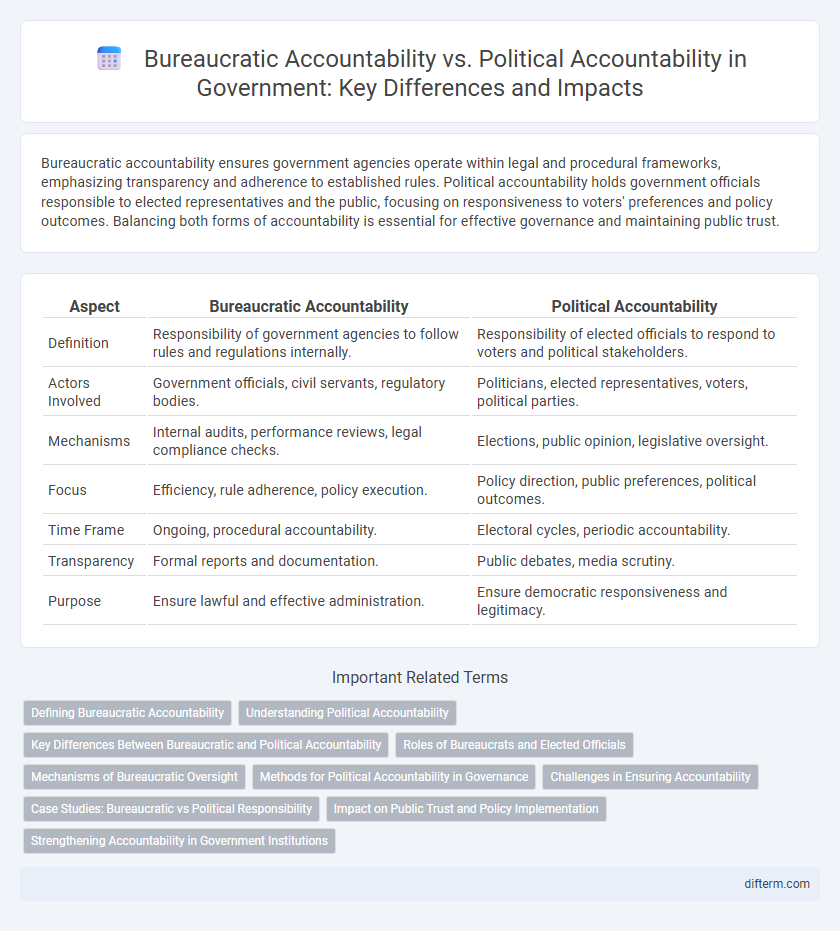Bureaucratic accountability ensures government agencies operate within legal and procedural frameworks, emphasizing transparency and adherence to established rules. Political accountability holds government officials responsible to elected representatives and the public, focusing on responsiveness to voters' preferences and policy outcomes. Balancing both forms of accountability is essential for effective governance and maintaining public trust.
Table of Comparison
| Aspect | Bureaucratic Accountability | Political Accountability |
|---|---|---|
| Definition | Responsibility of government agencies to follow rules and regulations internally. | Responsibility of elected officials to respond to voters and political stakeholders. |
| Actors Involved | Government officials, civil servants, regulatory bodies. | Politicians, elected representatives, voters, political parties. |
| Mechanisms | Internal audits, performance reviews, legal compliance checks. | Elections, public opinion, legislative oversight. |
| Focus | Efficiency, rule adherence, policy execution. | Policy direction, public preferences, political outcomes. |
| Time Frame | Ongoing, procedural accountability. | Electoral cycles, periodic accountability. |
| Transparency | Formal reports and documentation. | Public debates, media scrutiny. |
| Purpose | Ensure lawful and effective administration. | Ensure democratic responsiveness and legitimacy. |
Defining Bureaucratic Accountability
Bureaucratic accountability refers to the mechanisms through which government agencies and public officials are held responsible for their actions, ensuring compliance with laws, regulations, and internal policies. It involves oversight by internal controls, administrative procedures, and hierarchical supervision, distinct from political accountability, which depends on electoral processes and public opinion. Key entities such as inspector generals, audit institutions, and legislative committees play crucial roles in enforcing bureaucratic accountability within governmental organizations.
Understanding Political Accountability
Political accountability ensures elected officials answer to voters through elections, reinforcing democratic governance by aligning policies with public interests. It involves mechanisms such as voting, public debates, and media scrutiny that hold politicians responsible for their actions and decisions. Understanding political accountability is crucial for enhancing transparency and trust in government operations, distinguishing it from bureaucratic accountability, which primarily focuses on adherence to rules and administrative procedures within public agencies.
Key Differences Between Bureaucratic and Political Accountability
Bureaucratic accountability primarily involves adherence to rules, regulations, and procedures within public administration, ensuring efficiency, transparency, and compliance with established standards. Political accountability centers on elected officials being answerable to voters and legislative bodies, reflecting the public's preferences and democratic oversight. Key differences include bureaucratic accountability's focus on internal control mechanisms and technical expertise versus political accountability's emphasis on electoral legitimacy and responsiveness to public opinion.
Roles of Bureaucrats and Elected Officials
Bureaucrats implement policies and manage public programs, ensuring administrative efficiency and adherence to laws, which establishes bureaucratic accountability through procedures and regulations. Elected officials set policy agendas, represent public interests, and make legislative decisions, driving political accountability via electoral processes and public scrutiny. The distinct roles create a dynamic balance where bureaucrats provide expertise and continuity, while elected officials embody democratic control and responsiveness.
Mechanisms of Bureaucratic Oversight
Mechanisms of bureaucratic oversight include audits, performance evaluations, and internal review boards designed to ensure government agencies operate efficiently and within legal boundaries. Bureaucratic accountability relies on administrative procedures and professional standards, contrasting political accountability which is driven by elected officials and public opinion. These mechanisms safeguard against mismanagement by enabling continuous monitoring, reporting, and corrective action within the bureaucracy.
Methods for Political Accountability in Governance
Methods for political accountability in governance include regular elections, where citizens hold elected officials responsible through voting mechanisms, and legislative oversight that monitors executive actions. Public hearings and transparency initiatives enable citizens and watchdog organizations to scrutinize government decisions and performance. Media freedom and civil society engagement serve as crucial channels for exposing misconduct and ensuring political leaders answer to the public.
Challenges in Ensuring Accountability
Bureaucratic accountability faces challenges such as complex organizational structures and limited transparency, which hinder effective oversight and responsiveness. Political accountability is complicated by electoral cycles and partisan interests that may prioritize short-term gains over long-term governance outcomes. Both forms of accountability struggle with information asymmetry and the potential for conflicting objectives between bureaucrats and elected officials.
Case Studies: Bureaucratic vs Political Responsibility
Case studies on bureaucratic versus political accountability reveal distinct mechanisms shaping government performance and public trust. Bureaucratic accountability centers on adherence to regulations, procedural correctness, and expertise within administrative agencies, as demonstrated in the U.S. GAO audits and the UK's Civil Service Code enforcement. Political accountability is tied to electoral processes and responsiveness to citizens, exemplified by government officials' responsibility in parliamentary inquiries and electoral consequences following policy failures.
Impact on Public Trust and Policy Implementation
Bureaucratic accountability ensures compliance with established rules and procedures, promoting consistency but sometimes limiting flexibility in policy implementation, which can affect public trust when rigid processes hinder responsiveness. Political accountability, driven by elected officials' responsiveness to voters, often accelerates policy adaptation and fosters public trust by aligning decisions with citizens' preferences. Balancing both forms enhances effective governance by combining procedural integrity with democratic responsiveness, directly influencing public trust and the success of policy outcomes.
Strengthening Accountability in Government Institutions
Strengthening accountability in government institutions requires balancing bureaucratic accountability, which ensures adherence to rules, procedures, and ethical standards within public administration, with political accountability, which holds elected officials responsible to the electorate and legislative bodies. Enhancing transparency mechanisms, implementing rigorous performance evaluations, and establishing clear lines of responsibility support compliance and responsiveness across both dimensions. Integrating these accountability frameworks promotes more effective governance, reduces corruption, and improves public trust in government institutions.
bureaucratic accountability vs political accountability Infographic

 difterm.com
difterm.com